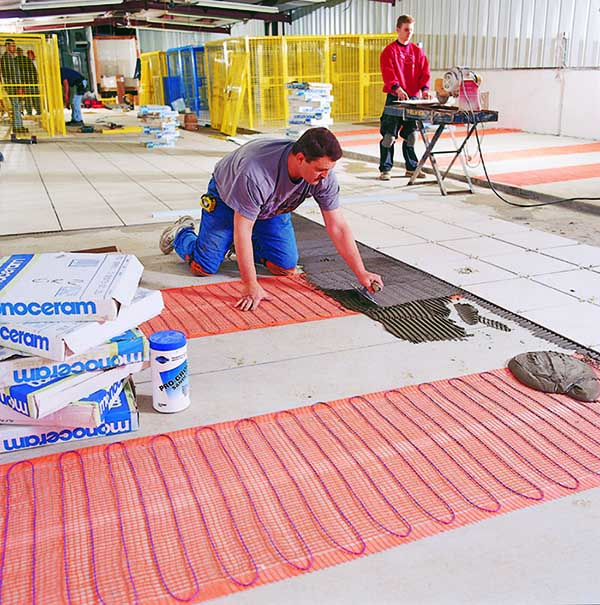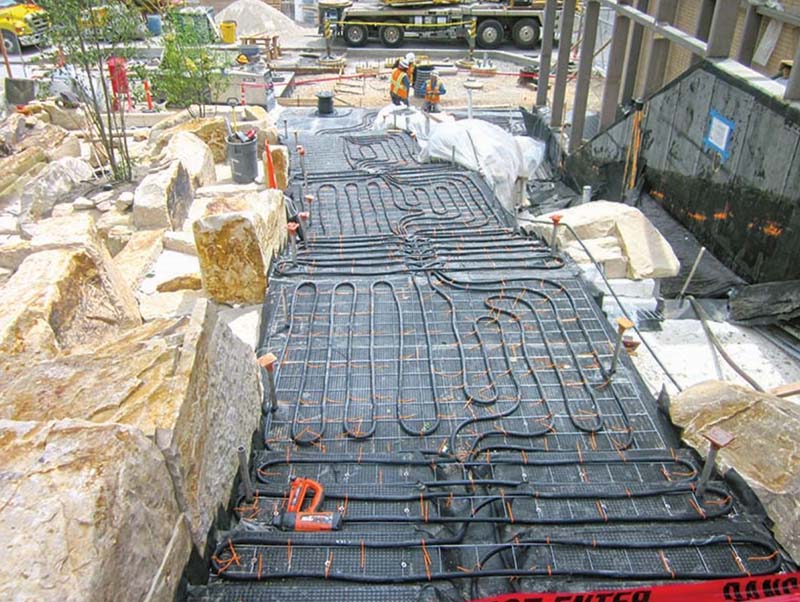Radiant is more than coils of PEX tubing under the ground. It is a technology with diverse applications. Often bearing the moniker ‘wet heat,’ radiant technology can range from common applications like bathroom floors and driveway installations to creative projects like walls and ceilings, sports fields, and golf course root zones. There are different types of radiant, such as geothermal to radiant, solar to radiant, and radiant floor warming as opposed to space heat. Don’t forget about electric radiant systems, either. Some contractors are even beginning to use the waste heat off their radiant systems to heat outdoor structures and hot tubs. Here are two examples of creative uses for radiant.
Radiant Technology in Zoos
The world may never know what happened to the Tiger King, but the Tulsa Zoo has invested in radiant heat applications across its Lost Kingdom exhibits, and its tiger habitat received a special surprise. Located in Tulsa, Oklahoma, this zoo has displays that give animals the choice of being indoors or outside, without concern for temperature. There are more than 100 square feet of warm areas for animals to sit and bask year round. The completed project, which opened in 2019, is a large exhibit resembling ancient Asian ruins. Animal such as Malayan tigers, snow leopards, binturongs (bearcats), red pandas, Siamang monkeys, and Komodo dragons dwell in the Lost Kingdom.
The in-slab radiant solutions constructed may seem traditional, but when the materials were routed through man-made rocks where Malayan tigers and Komodo dragons could sun themselves, the installation results moved to a new level of creativity. Guests to the exhibit also benefit from the radiant installations in the Lost Kingdom. In traditional zoo setting, the dens used for different species during inclement weather are often tucked away, keeping the animals out of sight several times throughout the year. The radiant spots throughout the Lost Kingdom exhibit, however, allow the animals to have visible dens and maintain comfort. No matter what the weather, the animals are comfortable and guests can always see them.

ELECTRIC RADIANT: The radiant system installed in this kennel will keep its occupants comfortable throughout the year.
Below the surface of the man-made rocks, Watts Radiant ProMelt electric snow and ice melt cable heat the surface, keeping them warm and dry. According to Greg Sutcliffe, engineer at Tulsa-based Phillips + Gomez, the hot rocks are strategically located to provide optimal viewing for guests while at the same time offering animals the chance to seek warmth whenever they like.
More than 50 lineal feet of the ProMelt snowmelt cable is encased in each of the 24-square-foot sunning beds, providing 50 watts per square foot.
“Typically, out of the factory, ‘cold leads’ — those parts of the wired ProMelt product that do not heat — are 10 feet long,” explained Cary Pestel, owner of Tulsa, Oklahoma-based Boone & Boone Sales, the manufacturer’s rep firm for the job. “These lengths of braided steel wire lead to the heating elements of the ProMelt cable. For the job at the zoo, they needed cold leads that were that much longer — 50 feet, in fact. Watts Radiant did that for us, no questions asked.”
Pestel explained that all of the Lost Kingdom’s interior radiant zones and hot rocks are hydronically heated.
“In-slab sensors send signals back to Watts Radiant’s pre-engineered, preassembled hydronic control panels — which pull water from two 50-gallon, 40,000 Btu electric water heaters — tasked with heating fluids for all of the interior radiant zones.”
Interior areas of the Malayan tiger exhibits have received in-slab radiant heating in addition to the exterior hot rocks. There, three separate hydronic radiant heat zones, served by 400 feet of half-inch RadiantPEX+, provides the tigers with warmth whenever they need it.
Radiant Technology and Tubing
Sometimes the creativity of radiant applications doesn’t come from the application type, but instead comes from the materials used to install the application. Many times, when contractors think radiant tubing, the word PEX comes to mind first. This widely used material is affordable, readily available, and chosen for diverse hydronic applications. There is another tubing, however, that provides a different set of creative abilities to radiant designers and installers.

FLEXIBILE APPLICATION: CCI Mechanical Inc. of Salt Lake City, Utah, used 2,400 lineal feet of 5/8-inch Onix EPDM synthetic rubber tubing for several exterior stairways.
The synthetic rubber tubing referred to as Onix remains flexible in frigid winter conditions and maintains structural integrity at temperatures above 180°F. The tubing is cross-linked EPDM, a synthetic rubber extruded into a tube and wrapped with an aluminum shield oxygen barrier and two more layers of EPDM. This flexible composite hose is reinforced with aramid cord, the same material used to make fire and bulletproof shields. Its aluminum barrier is unaffected by sunlight, UV radiation from fluorescent lamps, moisture, or elevated temperatures. Sandwiched between EPDM layers, the aluminum layer can’t be scraped off or damaged by typical jobsite abuse.
This piping was used in several spots in an open-air development that spans nearly 800,000 square feet (20 acres) of downtown Salt Lake City. A mechanical plan was developed and CCI Mechanical Inc. of Salt Lake City, Utah, was involved in several large-scale heating and cooling projects throughout the complex. The company used 2,400 lineal feet of 5/8-inch Onix EPDM synthetic rubber tubing for several exterior stairways.
“CCI requested that they be allowed to buy the tubing specifically for the stairways because of its superb flexibility — a valuable attribute when doing stairs and risers,” said Mike Lundquist, president of Lundquist Sales Inc.
The rubber hose’s ability to flex, even after it’s installed, also played into its specification on many radiant jobs.
“Naturally, we’re very proud of the work our crews did at City Creek Center,” said CCI’s Dave Katsanevas, vice president and senior partner. “Considering the overall scope and magnitude of the job, the duration of the project, and the involvement of many people at CCI, it’s been very rewarding for us to see it come to fruition this way.”



Report Abusive Comment